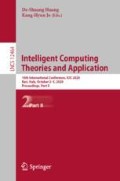Abstract
Protein-protein interactions (PPIs) play an important role in nearly every aspect of the cell function in biological system. A number of high-throughput technologies have been proposed to detect the PPIs in past decades. However, they have some drawbacks such as time-consuming and high cost, and at the same time, a high rate of false positive is also unavoidable. Hence, developing an efficient computational method for predicting PPIs is very necessary and urgent. In this paper, we propose a novel computational method for predicting PPIs from protein sequence using Locality Preserving Projections (LPP) and Rotation Forest (RF) model. Specifically, the protein sequence is firstly transformed into Position Specific Scoring Matrix (PSSM) generated by multiple sequences alignments. Then, the LPP descriptor is applied to extract protein evolutionary information from. Finally, the RF classifier is adopted to predict whether the given protein pair is interacting or not. When the proposed method performed on Yeast and H. pylori PPIs datasets, it achieved the results with an average accuracy of 92.52% and 91.46%, respectively. To further verify the performance of the proposed method, we compare the proposed method with the state-of-the-art support vector machine (SVM) and get good results. The promising results indicated the proposed method is stable and robust for predicting PPIs.
Access this chapter
Tax calculation will be finalised at checkout
Purchases are for personal use only
References
Wang, L., et al.: An ensemble approach for large-scale identification of protein-protein interactions using the alignments of multiple sequences. Oncotarget 8, 5149–5159 (2017)
Braun, P., Gingras, A.C.: History of protein-protein interactions from egg-white to complex networks. Proteomics 12, 1478–1498 (2012)
Gavin, A.C., et al.: Functional organization of the yeast proteome by systematic analysis of protein complexes. Nature 415, 141–147 (2002)
Bader, G.D., Doron, B., Hogue, C.W.: BIND: the biomolecular interaction network database. Nucleic Acids Res. 31, 248–250 (2003)
Xenarios, I., Salwinski, L., Duan, X.J., Higney, P., Kim, S.M., Eisenberg, D.: DIP, the Database of Interacting Proteins: a research tool for studying cellular networks of protein interactions. Nucleic Acids Res. 30, 303–305 (2002)
Licata, L., et al.: MINT, the molecular interaction database: 2012 update. Nucleic Acids Res. 40, D857–D861 (2012)
Bock, J.R., Gough, D.A.: Predicting protein–protein interactions from primary structure. Bioinformatics 17, 455–460 (2001)
Zhang, Q.C., et al.: Structure-based prediction of protein–protein interactions on a genome-wide scale. Nature 490, 556–560 (2012)
Aytuna, A.S., Gursoy, A., Keskin, O.: Prediction of protein–protein interactions by combining structure and sequence conservation in protein interfaces. Bioinformatics 21, 2850–2855 (2005)
Yi, H.C., You, Z.H., Huang, D.S., Li, X., Jiang, T.H., Li, L.P.: A deep learning framework for robust and accurate prediction of ncRNA-protein interactions using evolutionary information. Mol. Ther. Nucleic Acids 11, 337–344 (2018)
Valencia, A., Pazos, F.: Prediction of protein-protein interactions from evolutionary information. Methods Biochem. Anal. 44, 411–426 (2003)
Wang, Y., You, Z., Li, L., Chen, Z.: A survey of current trends in computational predictions of protein-protein interactions. Front. Comput. Sci. 14(4), 1–12 (2020). https://doi.org/10.1007/s11704-019-8232-z
An, J.Y., You, Z.H., Zhou, Y., Wang, D.F.: Sequence-based Prediction of Protein-Protein Interactions Using Gray Wolf Optimizer-Based Relevance Vector Machine. Evol. Bioinform. 15, 1176934319844522 (2019)
You, Z.H., Huang, W.Z., Huang, Y.A., Yu, C.Q., Li, L.P.: An efficient ensemble learning approach for predicting protein-protein interactions by integrating protein primary sequence and evolutionary information. IEEE/ACM Trans. Comput. Biol. Bioinform. 16, 809–817 (2018)
Wang, Y., You, Z.H., Li, X., Chen, X., Jiang, T., Zhang, J.: PCVMZM: using the probabilistic classification vector machines model combined with a zernike moments descriptor to predict protein–protein interactions from protein sequences. Int. J. Mol. Sci. 18, 1029 (2017)
You, Z.H., Chan, K.C., Hu, P.: Predicting protein-protein interactions from primary protein sequences using a novel multi-scale local feature representation scheme and the random forest. PLoS ONE 10, e0125811 (2015)
Huang, Y.A., You, Z.H., Gao, X., Wong, L., Wang, L.: Using weighted sparse representation model combined with discrete cosine transformation to predict protein-protein interactions from protein sequence. Biomed Res. Int. (2015)
Zhao, L.J., Chai, T.Y., Yuan, D.C.: Selective ensemble extreme learning machine modeling of effluent quality in wastewater treatment plants. Int. J. Autom. Comput. 9, 627–633 (2012)
Qi, Y., Bar, J.Z., Klein, S.J.: Evaluation of different biological data and computational classification methods for use in protein interaction prediction. Proteins: Struct., Funct., Bioinf. 63, 490–500 (2006)
Gribskov, M., McLachlan, A.D., Eisenberg, D.: Profile analysis: detection of distantly related proteins. Proc. Natl. Acad. Sci. 84, 4355–4358 (1987)
Huang, C., Yuan, J.: Using radial basis function on the general form of Chou’s pseudo amino acid composition and PSSM to predict subcellular locations of proteins with both single and multiple sites. Biosystems. 113, 50–57 (2013)
Altschul, S.F., et al.: Gapped BLAST and PSI-BLAST: a new generation of protein database search programs. Nucleic Acids Res. 25, 3389–3402 (1997)
He, X., Niyogi, P.: Locality preserving projections. Adv. Neural Inf Process. Syst. 2004, 153–160 (2004)
Rodriguez, J.J., Kuncheva, L.I., Alonso, C.J.: Rotation forest: a new classifier ensemble method. IEEE Trans. Pattern Anal. Mach. Intell. 28, 1619–1630 (2006)
Author information
Authors and Affiliations
Corresponding author
Editor information
Editors and Affiliations
Rights and permissions
Copyright information
© 2020 Springer Nature Switzerland AG
About this paper
Cite this paper
Zhan, X., You, Z., Yu, C., Pan, J., Li, R. (2020). Predicting Protein-Protein Interactions from Protein Sequence Using Locality Preserving Projections and Rotation Forest. In: Huang, DS., Jo, KH. (eds) Intelligent Computing Theories and Application. ICIC 2020. Lecture Notes in Computer Science(), vol 12464. Springer, Cham. https://doi.org/10.1007/978-3-030-60802-6_12
Download citation
DOI: https://doi.org/10.1007/978-3-030-60802-6_12
Published:
Publisher Name: Springer, Cham
Print ISBN: 978-3-030-60801-9
Online ISBN: 978-3-030-60802-6
eBook Packages: Computer ScienceComputer Science (R0)

